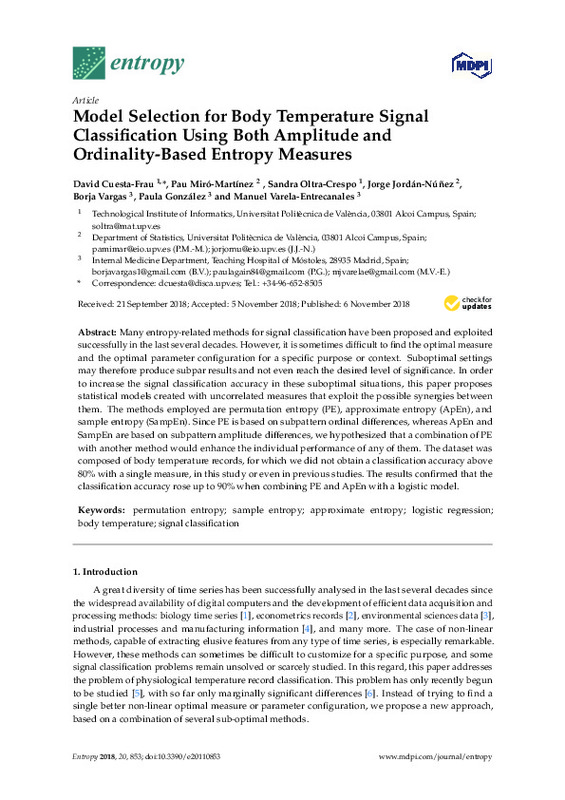JavaScript is disabled for your browser. Some features of this site may not work without it.
Buscar en RiuNet
Listar
Mi cuenta
Estadísticas
Ayuda RiuNet
Admin. UPV
Model Selection for Body Temperature Signal Classification Using Both Amplitude and Ordinality-Based Entropy Measures
Mostrar el registro sencillo del ítem
Ficheros en el ítem
| dc.contributor.author | Cuesta Frau, David
|
es_ES |
| dc.contributor.author | Miró Martínez, Pau
|
es_ES |
| dc.contributor.author | Oltra Crespo, Sandra
|
es_ES |
| dc.contributor.author | Jordán Núñez, Jorge
|
es_ES |
| dc.contributor.author | Vargas-Rojo, B.
|
es_ES |
| dc.contributor.author | González, Paula
|
es_ES |
| dc.contributor.author | Varela-Entrecanales, Manuel
|
es_ES |
| dc.date.accessioned | 2020-01-26T21:02:03Z | |
| dc.date.available | 2020-01-26T21:02:03Z | |
| dc.date.issued | 2018 | es_ES |
| dc.identifier.issn | 1099-4300 | es_ES |
| dc.identifier.uri | http://hdl.handle.net/10251/135622 | |
| dc.description.abstract | [EN] Many entropy-related methods for signal classification have been proposed and exploited successfully in the last several decades. However, it is sometimes difficult to find the optimal measure and the optimal parameter configuration for a specific purpose or context. Suboptimal settings may therefore produce subpar results and not even reach the desired level of significance. In order to increase the signal classification accuracy in these suboptimal situations, this paper proposes statistical models created with uncorrelated measures that exploit the possible synergies between them. The methods employed are permutation entropy (PE), approximate entropy (ApEn), and sample entropy (SampEn). Since PE is based on subpattern ordinal differences, whereas ApEn and SampEn are based on subpattern amplitude differences, we hypothesized that a combination of PE with another method would enhance the individual performance of any of them. The dataset was composed of body temperature records, for which we did not obtain a classification accuracy above 80% with a single measure, in this study or even in previous studies. The results confirmed that the classification accuracy rose up to 90% when combining PE and ApEn with a logistic model. | es_ES |
| dc.language | Inglés | es_ES |
| dc.publisher | MDPI AG | es_ES |
| dc.relation.ispartof | Entropy | es_ES |
| dc.rights | Reconocimiento (by) | es_ES |
| dc.subject | Permutation entropy | es_ES |
| dc.subject | Sample entropy | es_ES |
| dc.subject | Approximate entropy | es_ES |
| dc.subject | Logistic regression | es_ES |
| dc.subject | Body temperature | es_ES |
| dc.subject | Signal classification | es_ES |
| dc.subject.classification | ARQUITECTURA Y TECNOLOGIA DE COMPUTADORES | es_ES |
| dc.subject.classification | MATEMATICA APLICADA | es_ES |
| dc.subject.classification | ESTADISTICA E INVESTIGACION OPERATIVA | es_ES |
| dc.title | Model Selection for Body Temperature Signal Classification Using Both Amplitude and Ordinality-Based Entropy Measures | es_ES |
| dc.type | Artículo | es_ES |
| dc.identifier.doi | 10.3390/e20110853 | es_ES |
| dc.rights.accessRights | Abierto | es_ES |
| dc.contributor.affiliation | Universitat Politècnica de València. Departamento de Matemática Aplicada - Departament de Matemàtica Aplicada | es_ES |
| dc.contributor.affiliation | Universitat Politècnica de València. Departamento de Informática de Sistemas y Computadores - Departament d'Informàtica de Sistemes i Computadors | es_ES |
| dc.contributor.affiliation | Universitat Politècnica de València. Departamento de Estadística e Investigación Operativa Aplicadas y Calidad - Departament d'Estadística i Investigació Operativa Aplicades i Qualitat | es_ES |
| dc.description.bibliographicCitation | Cuesta Frau, D.; Miró Martínez, P.; Oltra Crespo, S.; Jordán Núñez, J.; Vargas-Rojo, B.; González, P.; Varela-Entrecanales, M. (2018). Model Selection for Body Temperature Signal Classification Using Both Amplitude and Ordinality-Based Entropy Measures. Entropy. 20(11):1-18. https://doi.org/10.3390/e20110853 | es_ES |
| dc.description.accrualMethod | S | es_ES |
| dc.relation.publisherversion | https://doi.org/10.3390/e20110853 | es_ES |
| dc.description.upvformatpinicio | 1 | es_ES |
| dc.description.upvformatpfin | 18 | es_ES |
| dc.type.version | info:eu-repo/semantics/publishedVersion | es_ES |
| dc.description.volume | 20 | es_ES |
| dc.description.issue | 11 | es_ES |
| dc.relation.pasarela | S\371847 | es_ES |








